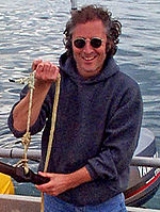
Gene Carl Feldman
Encyclopedia

NASA
The National Aeronautics and Space Administration is the agency of the United States government that is responsible for the nation's civilian space program and for aeronautics and aerospace research...
/ Goddard Space Flight Center
Goddard Space Flight Center
The Goddard Space Flight Center is a major NASA space research laboratory established on May 1, 1959 as NASA's first space flight center. GSFC employs approximately 10,000 civil servants and contractors, and is located approximately northeast of Washington, D.C. in Greenbelt, Maryland, USA. GSFC,...
since 1985. His primary interest has been to try and make the data that NASA gathers from its spaceborne fleet of Earth observing instruments, especially those monitoring the subtle changes in ocean color, as scientifically credible, readily understandable and as easily available to the broadest group of people possible. He has been involved in a number of past and present NASA missions including the Coastal Zone Color Scanner
Coastal Zone Color Scanner
The Coastal Zone Color Scanner was a multi-channel scanning radiometer aboard the Nimbus 7 satellite. Nimbus 7 was launched 24 October 1978, and CZCS became operational on 2 November 1978. It was only designed to operate for one year , but in fact remained in service until 22 June 1986...
(CZCS), the Sea-Viewing Wide Field Sensor (SeaWiFS
SeaWiFS
SeaWiFS stands for Sea-viewing Wide Field-of-view Sensor. It was the only scientific instrument on GeoEye's OrbView-2 satellite, and was a follow-on experiment to the Coastal Zone Color Scanner on Nimbus 7...
) and the Moderate Resolution Imaging Spectroradiometer (MODIS
MODIS
The Moderate-resolution Imaging Spectroradiometer is a payload scientific instrument launched into Earth orbit by NASA in 1999 on board the Terra Satellite, and in 2002 on board the Aqua satellite...
) and along with the NASA Ocean Biology Processing group which he co-leads, been given the responsibility for designing, implementing and operating the data processing and mission operations component of upcoming ocean salinity mission called Aquarius, a space mission developed by NASA and the Space Agency of Argentina - Comision Nacional de Actividades Espaciales (CONAE).
Prior to his work with NASA, his experience included extended service (3½ years) as a Peace Corps Volunteer in Western Samoa, where among other things he was involved in fish farming, sea turtle conservation, boat building and village fisheries development and work with the NOAA's National Marine Fisheries Service as a fisheries biologist in Seattle, Alaska and San Diego. These experiences led to his becoming a Graduate Research Fellow at the Marine Sciences Research Center, State University of New York at Stony Brook, where for his dissertation, he used satellite and oceanographic data to study the variability in, and the relationship between, the physical and biological processes in the ocean. He earned his Ph.D. in Coastal Oceanography in 1985.
External links
- NASA Biographical Webpage
- NASA's OceanColor Web
- Monitoring the Earth from Space with SeaWiFS
- SeaWiFS 10 Year Gloabl Biosphere Animation
- Climate Warming Reduces Ocean Food Supply
- Dr. Betsy Pugel interviews Dr. Gene Carl Feldman for “Straight from the Scientist’s. Mouth”
- From Sea to Shining Sea - A Film Treatment for a Documentary about the Ben Franklin
- Webcast of presentation given at the Library of Congress - 22 September 2010

